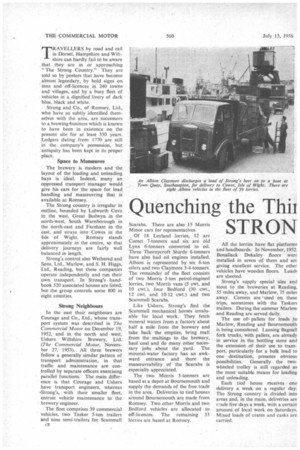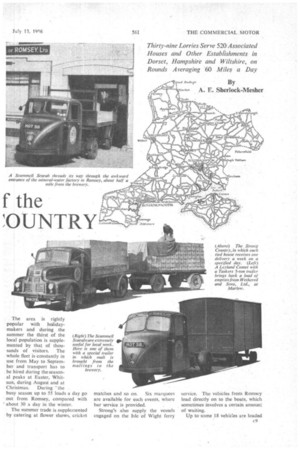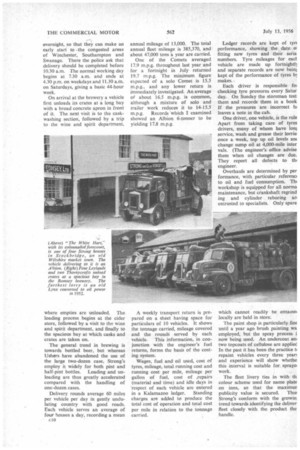uenching the Thii
Page 46

Page 47

Page 48

If you've noticed an error in this article please click here to report it so we can fix it.
f the _. 71-•
,
STRON
OUNTRY .11.1alreuers Thirty-nine Lorries Serve 520 Associated Houses and Other Establishments in Dorset, Hampshire and Wiltshire, on Rounds Averaging -60 Miles a Day ['weal d.. g" By
A. E. Sherlock-Mesher
TRAVELLERS by road and rail in Dorset, Hampshire and Wiltshire can hardly fail to be aware that they are in or approaching "The Strong Country." They are told so by posters that have become almost legendary, by bold signs on inns and off-licences in 240 towns and villages, and by a busy fleet of vehicles in a dignified livery of dark blue, black and white.
Strong and Co., of Romsey, Ltd., who have so subtly identified themselves with the area, are successors to a brewinrbusiness which is known to have been in existence on the present site for at least 350 years. Ledgers dating from 1770 are still in the company's possession, but antiquity has been kept in its proper place.
Space to Manceuvre The brewery is modern and the layout of the loading and unloading bays is ideal. Indeed, many an oppressed transport manager would give his ears for the space for load handling and manceuvring that is available at Romsey.
The Strong country is irregular in outline, bounded by Lulworth Cove in the west, Great Bedwyn in the north-west, South Warnborough in the north-east and Fareham in the east, and strays into Cowes in the Isle of Wight. Romsey stands approximately in the centre, so that delivery journeys are fairly well balanced in length.
Strong's control also Wethered and Sons, Ltd., Marlow, and S. H. Higgs, Ltd., Reading, but these companies operate independently and run their own transport. In Strong's handbook 520 associated houses are Listed, but the group controls some 800 in eight counties.
Strong Neighbours In the east their neighbours are Courage and Co., Ltd., whose transport system was described in The Commercial Motor on December 19, 1952, and in the north and west, Ushers Wiltshire Brewery, Ltd. (The Commercial Motor, November 27, 1953). All three brewers follow a generally similar pattern of transport administration, in that traffic and maintenance are controlled by separate officers exercising parallel functions. The main difference is that Courage and Ushers have transport engineers, whereas
• Strong's, with their smaller fleet, entrust vehicle maintenance to the brewery engineer.
The fleet comprises 39 commercial vehicles, two Tasker 5-ton trailers and nine semi-trailers for Scammell
CS Scarabs. There are also 15 Morris Minor cars for representatives.
Of 18 Leyland lorries, 12 are Comet 7-tonners and six are old Lynx 6-tonners converted to oil. Three Thornycroft Sturdy 6-tonners have also had oil engines installed. Albion is represented by six 6-ton oilers and two Claymore 3-4-tonners. The remainder of the fleet consists of two Morris 3-ton petrol-engined lorries, two Morris vans (5 cwt. and 10 cwt.), four Bedford (30 cwt., 12 cwt. and 10-12 cwt.) and two Scammell Scarabs.
Like Ushers, Strong's find the Scammell mechanical horses invaluable for local work. They fetch mineral waters from a factory about half a mile from the brewery and take back the empties, bring malt from the maltings to the brewery, haul coal and do many other necessary jobs about the yard. The mineral-water factory has an awkward entrance and there the manceuvrability of the Scarabs is especially appreciated.
The two Morris 3-tonners are based at a depot at Bournemouth and supply the demands of the free trade in the area. Deliveries to tied houses around Bournemouth are made from Romsey. Two other Morris and two Bedford vehicles are allocated to off-licences. The remaining 33 lorries are based at Romsey. All the lorries have flat platforms and headboards, In November, 1952, Bonallack Dekaloy floors were installed in seven of them and are giving excellent service. The other vehicles have wooden floors. Loads are sheeted.
Strong's supply special ales and stout to the breweries at Reading, 55 miles away, and Marlow, 75 miles away. Comets are -used on these trips, sometimes with the Taskers trailers. During the summer Marlow and Reading are served daily.
The use of pallets for loads to Marlow, Reading and Bournemouth is being considered. Lansing Bagnall fork trucks, with pallets, are already in service in the bottling store and the extension of their use to transport, particularly for a bulk load to one destination, presents obvious possibilities. Generally the twowheeled trolley is still regarded as the most suitable means for loading and unloading.
Each tied house receives one delivery a week on a regular day. The Strong country is divided into areas and, in the main, deliveries are rade five days a week, with a certain amount of local work on Saturdays. Mixed loads of crates and casks are carried. The area is rightly popular with holidaymakers and during the summer the thirst of the local population is supplemented by that of thousands of visitors. The whole fleet is constantly in use from May to September and transport has to be hired during the seasonal peaks at Easter, Whitsun, during August and at Christmas. During ' the busy season up to 55 loads a day go out from Romsey, compared with 'about 30 a day in the winter.
The summer trade is supplemented by catering at flower shows, cricket matches and so on. Six marquees are available for such events, where bar service is provided.
Strong's also supply the vessels engaged on the Isle of Wight ferry service. The vehicles from Romscy load directly on to the boats, which sometimes involves a certain amount of waiting_ Up to some 18 vehibles are loaded overnight, so that they can make an early start to -the congested areas of Winchester, Southampton and Swanage. There the police ask that delivery should be completed before 10.30 a.m. The normal working day begins at 7.30 a.m. and ends at 4.30 p.m. on weekdays and 11.30 a.m. on Saturdays, giving a basic 44-hour week.
On arrival at the brewery a vehicle first unloads its crates at a long bay with a broad concrete apron in front of it. The next visit is to the caskwashing section, followed by a trip to the wine and spirit department, where empties are unloaded. The loading process begins at the cider store, followed by a visit to the wine and spirit department, and finally to the spacious bay at which casks and crates are taken on.
The general trend in brewing is towards bottled beer, but whereas Ushers have abandoned the use of the large two-dozen case, Strong's employ it widely for both pint and half-pint bottles. Loading and unloading are thus greatly accelerated compared with the handling of one-dozen cases.
Delivery rounds average 60 miles per vehicle per day in gently undulating country with good roads. Each vehicle serves an average of four houses a day, recording a mean c I 0 annual mileage of 13,000. The total annual fleet mileage is 385,370, and about 47,000 tons 'a year are carried.
One of the Comets averaged 17.9 m.p.g. throughout last year and for a fortnight in July returned 19.7 m.p.g. The minimum figure expected of a solo Comet is 15.5 m.p.g., and any lower return is immediately investigated. An average of about 16.5 m.p.g. is common, although a mixture of solo and trailer work reduces it to 14-15.5 m.p.g. Records which I examined showed an Albion 6-tanner to be yielding 17.8 m.p.g.
A weekly transport return is prepared on a sheet having space for particulars of 10 vehicles. It shows the tonnage carried, mileage covered and the rounds served by each vehicle. This information, in conjunction with the engineer's fuel returns, forms the basis of the costing system.
Wages, fuel and oil used, cost of tyres, mileage, total running cost and running cost per mile, mileage per gallon of fuel, cost of .repairs (material and time) and idle days in 'respect of each vehicle are entered in a Kalamazoo ledger. Standing charges are added to produce the total cost of operation and total cost per mile in relation to the tonnage carried. Ledger records are kept of tyri performance, showing the date. 01 fitting new tyres and their Seria numbers. Tyre mileages for eact vehicle are made up fortnight13 and separate records are now beim kept of the performance of tyres b3 makes.
Each driver is responsible foi checking tyre pressures every Satur day. On Sunday the storeman test them and records them in a book If the pressures are incorrect hi leaves a note in the cab.
One driver, one vehicle, is the rule Apart from taking care of tyres drivers, many of whom have lore service, wash and grease their lorrie once a week, top up oil levels am change sump oil at 4,000-mile inter vals. (The engineer's office advise them when oil changes are due. They report all defects to till engineer.
Overhauls are determined by per formance, with particular referenci to oil and fuel consumption. Thi workshop is equipped for all norma maintenance, but crankshaft regrind ing and cylinder reboring an entrusted to specialists. Only spare which cannot readily be obtatnei locally are held in store.
The paint shop is particularly fine until a year ago brush painting wa employed, but the spray process i now being used. An undercoat am two topcoats of cellulose are applied In the past it has been the practice ti repaint vehicles every three year5. and experience will show whethe this interval is suitable for sprayel work, The fleet livery ties in with th colour scheme used for name plate on inns, so that the maximun
publicity value is secured. Thuo Strong's conform with the growini trend towards identifying the deliver fleet closely with the product the. handle.












































































































